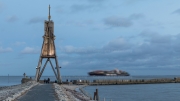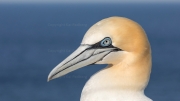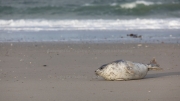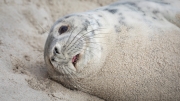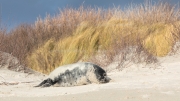Heligoland is a German archipelago in the North Sea consisting of the main island (“Helgoland”) and the neighboring “Düne”. Its distance to the mainland of Europe measures roughly 50 km.
One can go to Heligoland by boat or by plane privately or using regular services. In winter the only link by boat is the ferry – almost a cruise ship – from and to Cuxhaven at the mouth of the river Elbe into the North Sea.
For over 300 years navigators approaching or leaving Cuxhaven sight a wooden “Kugelbake” (ball beacon) marking the northernmost point of Lower Saxony. Easily accessible by land it’s a famous tourist attraction too.
Heligoland mainland is towered by Heligoland lighthouse, a former military defense tower replacing the destroyed original lighthouse. In clear nights its light is visible at the continental coast. A smaller lighthouse together with a lower leading light directs the way to Heligoland “Düne”.
The red cliffs, especially the “Lange Anna” (“Tall Anna”) sea stack are the landmark of Heligoland mainland.
On an early summer morning the cliffs are glowing red – as if bunkering solar energy.
The “Lange Anna” (“Tall Anna”) sea stack is an ideal nesting place for mainly gannets and guillemots. The whole rock is covered with nesting birds.
Nest-building is in progress the whole day long.
A nest needs mates.
Preparing the new generation is the next logical step.
The steep cliffs are exposed to the mainly westerly winds. Coastal preservation is necessary to protect the island. Storm floods and waves lift and move even tons weighing tetrapods.
The bunker of Heligoland gave shelter to the people during wartime. Today guided tours make it accessible.
A small ferry sailing every half hour during daytime links the “Düne” with Heligoland mainland. The cemetery of the anonymous at the southwestern corner of the “Düne” reminds one of the dangers of the seas.
The “Düne” hosts a growing population of grey seals. In winter they give birth to their pups. 423 seals saw the light of day from November 2017 till yearend. 529 seals were born in winter 2019 until New Year’s eve. One stumbles over them everywhere on the island.
30 m are the recommended distance to keep. As long as you keep calm the curious predators (don’t forget!) approach the photographer sometimes almost posing.
On New Year’s eve public fireworks over the harbour greets the new year.



